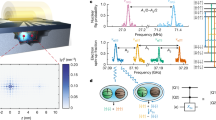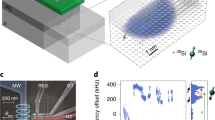Abstract
Quantum computers promise to exceed the computational efficiency of ordinary classical machines because quantum algorithms allow the execution of certain tasks in fewer steps. But practical implementation of these machines poses a formidable challenge. Here I present a scheme for implementing a quantum-mechanical computer. Information is encoded onto the nuclear spins of donor atoms in doped silicon electronic devices. Logical operations on individual spins are performed using externally applied electric fields, and spin measurements are made using currents of spin-polarized electrons. The realization of such a computer is dependent on future refinements of conventional silicon electronics.
This is a preview of subscription content, access via your institution
Access options
Subscribe to this journal
Receive 51 print issues and online access
$199.00 per year
only $3.90 per issue
Buy this article
- Purchase on Springer Link
- Instant access to full article PDF
Prices may be subject to local taxes which are calculated during checkout




Similar content being viewed by others
References
Steane, A. Quantum computing. Rep. Prog. Phys. 61, 117–173 (1998).
Bennett, C. H. Quantum information and computation. Physics Today 24–30 (Oct. (1995).
Shor, P. W. in Proc. 35th Annu. Symp. Foundations of Computer Science (ed. Goldwasser, S.) 124–134 (IEEE Computer Society, Los Alamitos, CA, 1994).
Ekert, A. & Jozsa, R. Quantum computation and Shor's factoring algorithm. Rev. Mod. Phys. 68, 733–753 (1996).
Grover, L. K. Quantum mechanics helps in searching for a needle in a haystack. Phys. Rev. Lett. 79, 325–328 (1997).
Calderbank, A. R. & Shor, P. W. Good quantum error correcting codes exist. Phys. Rev. A 54, 1098–1105 (1996).
Steane, A. M. Error correcting codes in quantum theory. Phys. Rev. Lett. 77, 793–797 (1996).
Preskill, J. Reliable quantum computers. Proc. R. Soc. Lond. A 454, 385–410 (1998).
Lloyd, S. Apotentially realizable quantum computer. Science 261, 1569–1571 (1993).
DiVincenzo, D. P. Quantum computation. Science 270, 255–261 (1995).
Gershenfeld, N. A. & Chuang, I. L. Bulk spin-resonance quantum computation. Science 275, 350–356 (1997).
Cory, D. G., Fahmy, A. F. & Havel, T. F. Ensemble quantum computing by NMR spectroscopy. Proc. Natl Acad. Sci. USA 94, 1634–1639 (1997).
Loss, D. & DiVincenzo, D. P. Quantum computation with quantum dots. Phys. Rev. A 57, 120–126 (1998).
Privman, V., Vagner, I. D. & Kventsel, G. Quantum computation in quantum Hall systems. Phys. Lett. A 239, 141–146 (1998)..
Slichter, C. P. Principles of Magnetic Resonance3rd edn, Ch 4 (Springer, Berlin, 1990).
Dobers, M., Klitzing, K. v., Schneider, J., Weimann, G. & Ploog, K. Electrical detection of nuclear magnetic resonance in GaAs-AlxGa1−xAs heterostructures. Phys. Rev. Lett. 61, 1650–1653 (1988).
Stich, B., Greulich-Weber, S. & Spaeth, J.-M. Electrical detection of electron nuclear double resonance in silicon. Appl. Phys. Lett. 68, 1102–1104 (1996).
Kane, B. E., Pfeiffer, L. N. & West, K. W. Evidence for an electric-field-induced phase transition in a spin-polarized two-dimensional electron gas. Phys. Rev. B 46, 7264–7267 (1992).
Wald, K. W., Kouwenhoven, L. P., McEuen, P. L., van der Vaart, N. C. & Foxon, C. T. Local dynamic nuclear polarization using quantum point contacts. Phys. Rev. Lett. 73, 1011–1014 (1994).
Dixon, D. C., Wald, K. R., McEuen, P. L. & Melloch, M. R. Dynamic polarization at the edge of a two-dimensional electron gas. Phys. Rev. B 56, 4743–4750 (1997).
CRC Handbook of Chemistry and Physics 77th edn 11–38 (CRC Press, Boca Raton, Florida, 1996).
Feher, G. Electron spin resonance on donors in silicon. I. Electronic structure of donors by the electron nuclear double resonance technique. Phys. Rev. 114, 1219–1244 (1959).
Wilson, D. K. & Feher, G. Electron spin resonance experiments on donors in silicon. III. Investigation of excited states by the application of uniaxial stress and their importance in relaxation processes. Phys. Rev. 124, 1068–1083 (1961).
Waugh, J. S. & Slichter, C. P. Mechanism of nuclear spin-lattice relaxation in insulators at very low temperatures. Phys. Rev. B 37, 4337–4339 (1988).
Kohn, W. Solid State Physics Vol. 5(eds Seitz, F. & Turnbull, D.) 257–320 (Academic, New York, 1957).
DiVincenzo, D. P. Two-bit gates are universal for quantum computation. Phys. Rev. A 51, 1015–1021 (1995).
Lloyd, S. Almost any quantum logic gate is universal. Phys. Rev. Lett. 75, 346–349 (1995).
Herring, C. & Flicker, M. Asymptotic exchange coupling of two hydrogen atoms. Phys. Rev. 134, A362–A366 (1964).
Andres, K., Bhatt, R. N., Goalwin, P., Rice, T. M. & Walstedt, R. E. Low-temperature magnetic susceptibility of Si:P in the nonmetallic region. Phys. Rev. B 24, 244–260 (1981).
Ashcroft, N. W. & Mermin, N. D. in Solid State PhysicsCh. 32 (Saunders College, Philadelphia, 1976).
Larsen, D. M. Stress dependence of the binding energy of D− centers in Si. Phys. Rev. B 23, 5521–5526 (1981).
Larsen, D. M. & McCann, S. Y. Variational studies of two- and three-dimensional D− centers in magnetic fields. Phys. Rev. B 46, 3966–3970 (1992).
Ashoori, R. C. Electrons in artificial atoms. Nature 379, 413–419 (1996).
Abragam, A. Principles of Nuclear Magnetism (Oxford Univ. Press, London, 1961).
Lyding, J. W. UHV STM nanofabrication: progress, technology spin-offs, and challenges. Proc. IEEE 85, 589–600 (1997).
Adams, C. S., Sigel, J. & Mlynek, J. Atom optics. Phys. Rep. 240, 143–210 (1994).
Warren, W. S. The usefulness of NMR quantum computing. Science 277, 1688–1690 (1997).
Acknowledgements
This work has been supported by the Australian Research Council. I thank R.G.Clark for encouragement and E. Hellman for suggesting that the work in ref. 18 could be relevant to quantum computation.
Author information
Authors and Affiliations
Corresponding author
Rights and permissions
About this article
Cite this article
Kane, B. A silicon-based nuclear spin quantum computer. Nature 393, 133–137 (1998). https://doi.org/10.1038/30156
Received:
Accepted:
Issue Date:
DOI: https://doi.org/10.1038/30156
This article is cited by
-
Microwave quantum diode
Nature Communications (2024)
-
EUV-induced hydrogen desorption as a step towards large-scale silicon quantum device patterning
Nature Communications (2024)
-
Efficiency optimization in quantum computing: balancing thermodynamics and computational performance
Scientific Reports (2024)
-
Study on the correlation properties in the three-qubit spin chain of Heisenberg XYZ model
Quantum Information Processing (2024)
-
Quantum dense coding and teleportation based on two coupled quantum dot molecules influenced by intrinsic decoherence, tunneling rates, and Coulomb coupling interaction
Applied Physics B (2024)
Comments
By submitting a comment you agree to abide by our Terms and Community Guidelines. If you find something abusive or that does not comply with our terms or guidelines please flag it as inappropriate.



